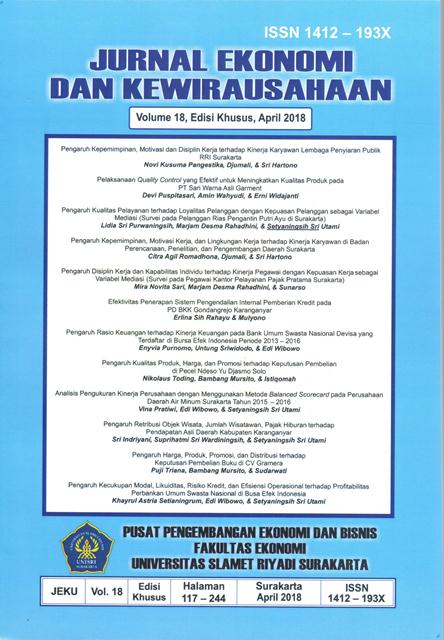PELAKSANAAN QUALITY CONTROL YANG EFEKTIF UNTUK MENINGKATKAN KUALITAS PRODUK PADA PT SARI WARNA ASLI GARMENT
Abstract
The aims of this research were to 1) Analyzing the factors that influence the quality control of PT Sari Warna Asli Garment 2) To formulate the most appropriate production quality control techniques to suppress defective products in the processing industry of PT Sari Warna Asli Garment. This research used to check sheet, Histogram, Pareto Chart, Back Map P and layered quality control methods. The result of this research indicate that the level of damage or defective products PT Sari Warna Asli Garment during November – December 2017, varieties step were 120 pieces, hit by needle step were 111 pieces, by loss of component were 98 pieces, by tension were 71 pieces and cut by scissors were 32 pieces. Thus hypotesis 1 (H1) which states the quality control of production at PT Sari Warna Asli Garment was influenced by several factors, among others: perforation due to scissors, perforated due to exposed dirt and loss of components proved true. Trough quality control activities in layered PT Sari Warna Asli Garment could suppress the defect rate of production and maintain the quality of the products produced. Hence hypothesis 2 (H2) that the application of double or layered checking method in controlling product quality of PT Sari Warna Asli Garment could suppress the occurrence of product defects can prove the truth.Keywords: Production, Product, Quality.
Downloads
Published
2018-12-04
Issue
Section
Artikel
License
Authors who publish this journal agree to the following terms:
- Authors retain copyright and grant the journal right of first publication with the work simultaneously licensed under a Creative Commons Attribution License that allows others to share the work with an acknowledgement of the work's authorship and initial publication in this journal.
- Authors can separately make additional contractual arrangements for non-exclusive distribution published by the journal (e.g., publish it in a book), with an acknowledgement of its initial publication in this journal.
- Authors are allowed and encouraged to send their work via online (e.g., in the institutional repositories or their website) after published by the journal.









